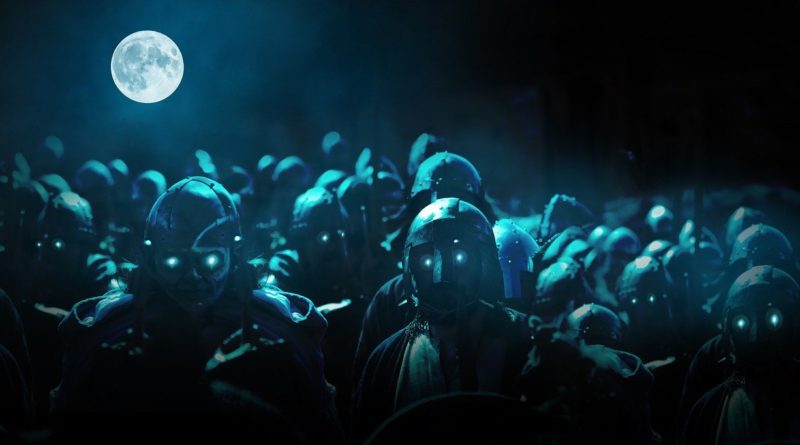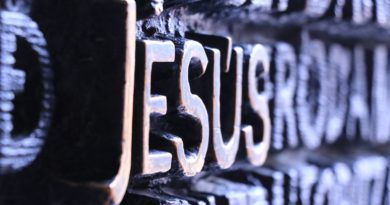The Armageddon Army
By Derek Gilbert
Every so often, someone asks why I spend so much time studying the giants mentioned in the Bible. The implication is that the giants, variously called Anakim, Rephaim, and Nephilim, are “fringe,” and thus irrelevant. Isn’t Jesus enough?
Yes, of course he is. But contrary to what’s being taught in seminaries, the “mighty men who were of old” are not “fringe;” they are, in fact, woven through the Bible from Genesis to Revelation. The prophets and apostles knew about them, and texts from pagan kingdoms around ancient Israel, some of which have only been translated within the last forty years, are helping us put these characters into their proper context.
In the Canaanite Rephaim Texts, “Travelers” are spirits who “travel” or “crossover” from one plane of existence to another, from the realm of the dead to the land of the living—in other words, demons, the spirits of the Nephilim destroyed in the days of Noah. It’s significant because “Traveler” can be interpreted as a divine name in Ezekiel’s prophecy of the Gog-Magog war.
On that day I will give to Gog a place for burial in Israel, the Valley of the Travelers, east of the sea. It will block the travelers, for there Gog and all his multitude will be buried. It will be called the Valley of Hamon-gog.
Ezekiel 39:11, ESV (emphasis added)
These Travelers, the Rephaim, were also called “warriors of Baal” in the Rephaim Texts. The reference to the Travelers in Ezekiel 39 is not just significant, it’s critical. The pagan Amorites of Canaan venerated spirits of the dead for centuries before Israel arrived. That’s why God prohibited consulting with mediums and necromancers, and why He sent a plague against Israel, before the people crossed the Jordan to march around Jericho, for eating sacrifices offered to the dead.
Ezekiel places the Valley of the Travelers east of the Dead Sea, an area where the veil between the worlds was believed to be thin. Place names along the Exodus route in Moab include Oboth (“Spirits of the Dead”), Peor (“cleft” or “gap,” which in this context refers to the entrance to the netherworld), and Iye-Abarim (“Ruins of the Travelers”). Mount Nebo, across the Jordan from Jericho, is called the “mountain of the Abarim (Travelers).”

The Sodom and Gomorrah Enigma
Archaeologists working at Tall el-Hammam, a site about seven and a half miles northeast of the Dead Sea, have uncovered physical evidence that strongly suggests it was the site of Sodom. A thriving city with massive defensive walls appears to have been leveled around 1700 B.C. in a single, cataclysmic event that left it and the fertile plain around it uninhabited for the next six to seven hundred years, about the time of Saul, David, and Solomon. Just southeast of the city is a cluster of about five hundred dolmens, megalithic funerary monuments that scholars date to the Early Bronze Age, possibly as old as 3300 B.C. It’s estimated that as many as fifteen hundred once stood there, along with menhirs (standing stones), henges, and stone circles, the largest such collection of megalithic structures in the Levant.
The site rises 75 to 150 feet above the plain. So, the stone monuments and the ruined, still-deserted city would have been easily visible to the Israelites who camped on the plains of Moab. It’s even possible that their stop at Iye-Abarim, “Ruins of the Travelers,” was among the rubble of the city that God destroyed with fire from the sky.
Dr. Phillip Silvia, the director of scientific analysis for the Tall el-Hammam Excavation Project, told me in a 2019 interview that the dolmens, unlike some others in the Jordan valley, don’t appear to be aligned with any astronomical features. Instead, they appear to be oriented toward what project archaeologists believe was the temple of Tall el-Hammam.

We’re eagerly waiting to see what the ongoing dig turns up, but this is a tantalizing bit of information. Consider: The east side of the Jordan valley is where the Bible places the Rephaim tribes in the days of Abraham. Some twenty-five thousand dolmens have been found along the Jordan from the Golan Heights (ancient Bashan) to the Dead Sea, with the largest concentration of them just outside the walls of Sodom—the largest and most influential city in the Transjordan until the time of Abraham and Lot. Scholars date the construction of the dolmens to time of the Rephaim, the Early and Middle Bronze Ages (roughly 3300–1800 B.C.), which coincides almost exactly with the period that Sodom dominated the region. Those dolmens apparently faced the city’s temple.
That begs the question: Who or what was worshiped in that temple? Why was God compelled to destroy the city and those around it? In my view, His judgment was about more than just the Sodomites’ choice of lifestyle.
The Hebrew prophets, especially Isaiah and Ezekiel, were clearly familiar with the pagan cult of the dead. References to the Rephaim are there in the original Hebrew, but they’ve been obscured by translators who may not have understood the historical and religious milieu of the ancient Near East.

Ezekiel Prophesied Return of Nephilim at Armageddon
Let’s start with Ezekiel, who prophesied the return of the Nephilim at Armageddon. The spirits of the Rephaim are the Travelers, the demon warriors of Baal (Satan) who make up the army of Gog (Antichrist) at the final battle for Zion.
That may sound crazy but consider: Since this happens on the Day of the Lord, the day of His terrible judgment on the world, the church won’t be here. We are not destined to suffer His wrath. With Christians gone, those still on the earth will not be protected by the Holy Spirit from this demonic army. What the people of Jerusalem face in that final battle is an attacking force possessed by the Travelers—demonic spirits of the “mighty men who were of old,” the Nephilim, following their spirit fathers into battle for one final assault on the holy mountain of God.

It will quite literally be an army of the evil dead.
This brings us to Isaiah 14, where we find the Rephaim, translated into English as “shades,” welcoming the divine rebel upon his fall from Eden.
Sheol beneath is stirred up
to meet you when you come;
it rouses the shades [Rephaim] to greet you,
all who were leaders of the earth;
it raises from their thrones
all who were kings of the nations. (Isaiah 14:9, ESV)
The description by Isaiah matches the sense of the term in the pagan Rephaim Texts from five hundred years earlier: The Rephaim were dead kings of old who now inhabit the netherworld. The main difference is that the Amorites believed those spirits of the dead would bless and protect their kings, while Isaiah described them as “weak,” sleeping beneath worms on a bed of maggots.

The Long Supernatural War We’re Deployed In
Isaiah 14 is, without a doubt, one of the most important chapters in the Bible for understanding this long supernatural war in which you and I are deployed. It tells us about the divine rebel, Day Star (Lucifer), son of Dawn, and his fall from Eden. The five “I wills” that illustrate his destructive pride and ambition. But Isaiah’s report on Lucifer’s fall is even more fascinating that we’ve been taught.
First, because Isaiah identified Lucifer’s mount of assembly as Mount Zaphon, the mountain sacred to Baal (whom Jesus identified as Satan), we can be pretty sure that Satan is in view here.
Second, the prophet, who is known for his love of wordplay, employed an Egyptian loanword to reveal more about the final destiny of the rebel god.
All the kings of the nations lie in glory,
each in his own tomb;
but you are cast out, away from your grave,
like a loathed branch,
clothed with the slain, those pierced by the sword,
who go down to the stones of the pit,
like a dead body trampled underfoot.
Isaiah 14:18–19, ESV (emphasis added)
What did Isaiah mean by calling Satan “a loathed branch?”
Most English translations agree that the Hebrew word netser means “branch.” The range of adjectives chosen by translators includes “loathed,” “repulsive,” “rejected,” “worthless,” and “abominable,” but they convey the same sense—something utterly detestable. The adjective translated “abhorred” or “abominable,” Hebrew taʿab, is significant. It modifies the noun netser, which would normally have a positive connotation. In this context, taʿab means something like “unclean” or “ritually impure.”
Still, even allowing for differences in cultures over the last twenty-seven hundred years, calling someone an “unclean branch” is puzzling. But there is an explanation: Isaiah meant something other than “branch” because the Hebrew netser wasn’t the word he used at all. Christopher B. Hays wrote this in the Journal of Ancient Egyptian Interconnections:
[The] term is best explained as a loanword from the common Egyptian noun nṯr. Nṯr is generally translated “god,” but is commonly used of the divinized dead and their physical remains. It originally came into Hebrew as a noun referring to the putatively divinized corpse of a dead king, which is closely related to the Egyptian usage. (Emphasis added)
“Divinized dead” describes perfectly the Rephaim, the Nephilim spirits venerated by the Amorites of Canaan, whom the prophet mentioned above, in verse 9. Isaiah used an Egyptian word that sounds like the Hebrew word for “branch” to connect the rebel from Eden to the Rephaim by calling Satan an abhorrent dead god.
This definitionfits. Satan was thrown down from Eden to the netherworld and demoted from “an anointed guardian cherub” to become the unclean, repugnant, eternally cursed lord of the dead.
What humiliation.


Derek Gilbert hosts SkyWatchTV, a weekly Christian television program, and co-hosts SciFriday, a weekly television program that looks at science news with his wife, author, and analyst Sharon K. Gilbert. His broadcast career spans nearly four decades, with stops in Little Rock, Saint Louis, and Philadelphia, and he’s been interviewing guests for his podcast, A View from the Bunker, since 2009. Derek is author of the groundbreaking books The Great Inception and Last Clash of the Titans. He’s also the co-author with Josh Peck of The Day the Earth Stands Still, which exposes the occult origins of the modern UFO phenomenon. Bad Moon Rising: Islam, Armageddon, and the Most Diabolical Double-Cross in History was released in the summer of 2019. Derek and Sharon recently released their newest book, Veneration: Unveiling the Ancient Realms of Demonic Kings and Satan’s Battle Plan for Armageddon, about ancient death cults and the Bible. Their newest book, Giants, Gods, and Dragons: Exposing the Fallen Realm and the Plot to Ignite the Final War of the Ages, will be released November 30. Derek is a popular conference speaker, a lifelong fan of the Chicago Cubs, prefers glasses to contacts, and has been known to sing the high part in barbershop and gospel quartets. Find out more: www.derekpgilbert.com, www.gilberthouse.org, www.vftb.net, and www.SkyWatchTV.com.




I think your onto something here… far beyond what the 501C3 church structure can endure in the USA…